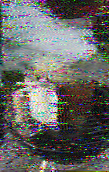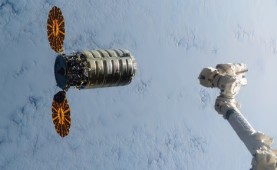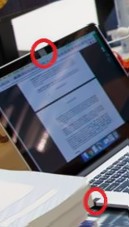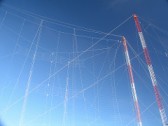██╗██████╗ ██████╗ ██████╗ █████╗ ██████╗ ██╗ ██████╗ ██████╗ ██████╗ █████╗ ███╗ ███╗
██║██╔══██╗██╔════╝ ██╔══██╗██╔══██╗██╔══██╗██║██╔═══██╗██╔════╝ ██╔══██╗██╔══██╗████╗ ████║
██║██████╔╝██║ ██████╔╝███████║██║ ██║██║██║ ██║██║ ███╗██████╔╝███████║██╔████╔██║
██║██╔══██╗██║ ██╔══██╗██╔══██║██║ ██║██║██║ ██║██║ ██║██╔══██╗██╔══██║██║╚██╔╝██║
██║██████╔╝╚██████╗ ██║ ██║██║ ██║██████╔╝██║╚██████╔╝╚██████╔╝██║ ██║██║ ██║██║ ╚═╝ ██║
╚═╝╚═════╝ ╚═════╝ ╚═╝ ╚═╝╚═╝ ╚═╝╚═════╝ ╚═╝ ╚═════╝ ╚═════╝ ╚═╝ ╚═╝╚═╝ ╚═╝╚═╝ ╚═╝
RSID: <<2016-06-29T20:30Z MFSK-32
@ 6070000+1515>>
START START START START
QUESTA E' IBC, ITALIAN BROADCASTING CORPORATION
TRASMISSIONI IN ITALIANO
OGNI MERCOLEDI' 20-22 UTC 6070 KHZ
OGNI VENERDI' 01-01.30 UTC 9955 KHZ
OGNI SABATO 01.30-02 UTC 11580 KHZ
website: HTTP://WWW.IBCRADIO.WEBS.COM
email: IBC@EUROPE.COM
"IBC DIGITAL" "IBC DIGITAL" "IBC DIGITAL" "IBC DIGITAL"
OGNI MERCOLEDI' 20.30-21.00 UTC 6070 KHZ AM TRASMETTIAMO:
--"QUANDO IBC - ITALIAN BROADCASTING CORPORATION - SI CHIAMAVA COMPAGNIA
ITALIANA DI RADIODIFFUSIONE" IN MFSK32 (1500 Hz)
--"DX NEWS DX ITALIA", NOTIZIE PER RADIOMATORI TRATTE DAL BOLLETTINO DI I2MQP,
IN OLIVIA 16-500 (2200 Hz)
BUONA DECODIFICA!
START START START START
Dies ist "IBC, ITALIAN BROADCASTING CORPORATION
ÜBERTRAGUNGEN IN ITALIENISCH
JEDEN MITTWOCH 20.00 - 22.00 UTC 6070 KHZ
JEDEN FREITAG 01.00 - 01.30 UTC 9955 KHZ
JEDEN SAMSTAG 01.30 - 02.00 UTC 11580 KHZ
website: HTTP://WWW.IBCRADIO.WEBS.COM
email: IBC@EUROPE.COM
"IBC DIGITAL" "IBC DIGITAL" "IBC DIGITAL" "IBC DIGITAL"
JEDEN MITTWOCH 20: 30 bis 21:00 UTC 6070 KHZ
AM
SENDEN WIR:
- "ALS SICH IBC - ITALIAN BROADCASTING CORPORATION - NOCH
COMPAGNIA
ITALIANA DI RADIODIFFUSIONE"
NANNTE" IN MFSK32 (1500 Hz)
--"DX NEWS DX ITALIA", NOTIZIE PER RADIOMATORI TRATTE DAL BOLLETTINO DI I2MQP,
IN OLIVIA 16-500 (2200 Hz)
BUONA DECODIFICA!
LA STORIA DI IBC - ITALIAN BROADCASTING CORPORATION
.
.
(immagine dello studio nel 1979)
.
Sending Pic:400x259Cp4;
.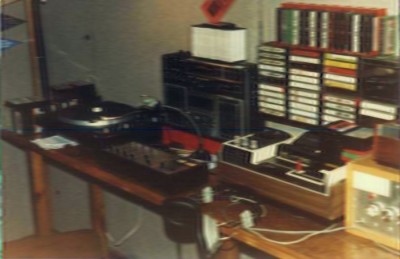
1,5 W, 6240 KHZ, 3 LUGLIO 1979, per la prima volta in Italia una emittente
privata e indipendente, in onde corte, diffonde il suo segnale nell'etere: è
la "COMPAGNIA ITALIANA DI RADIODIFFUSIONE"; questo nome fu presto abbandonato
per utilizzare quello inglese di ITALIAN BROADCASTING CORPORATION – IBC RADIO.
E' veramente emozionante ricordare le vicissitudini, i problemi, i successi e
le traversie di quello che da gioco, si trasformò in una iniziativa di grandi
consensi.
IBC iniziò le proprie trasmissioni con un trasmettitore surplus militare di 10
W di potenza, ma che effettivamente erogava poco più di 1 W, con la sua
antenna telescopica, timidamente svettante attraverso l’abbaino di una
soffitta, in una città del centro Italia. Dopo le prime prove comunque, grazie
anche alla collaborazione di amici tecnici dilettanti, fu realizzato un
piccolo trasmettitore transistorizzato da 2 W, che a sua volta pilotava uno
stadio finale di "ben" 10 W, il tutto camuffato in una comune scatola da
scarpe (immagine del trasmettitore)
.
.
Sending Pic:400x273p4;
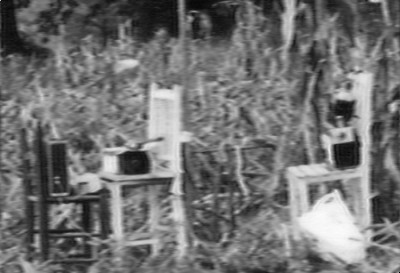
DIE GESCHICHTE DER IBC - ITALIAN Broadcasting Corporation
.
.
(Bild des Studios im Jahr 1979)
.
Senden Pic: 400x259Cp4;
.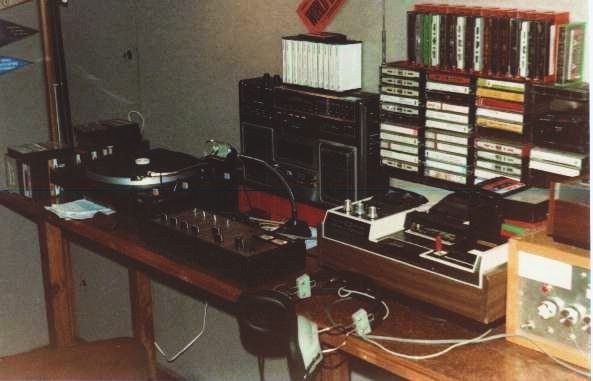 (aus
dem Internet)
(aus
dem Internet)
1,5 W, 6240 KHZ, 3. Juli 1979: Zum ersten Mal gab es in Italien eine private
und unabhängige Rundfunkstation, die ihre Signale über Kurzwelle verbreitete.
Es ist die "ITALIENISCHE GESELLSCHAFT FÜR RUNDFUNKVERBREITUNG".
Dieser Name wurde bald aufgegeben und durch die englische Bezeichnung
"ITALIAN BROADCASTING CORPORATION -
IBC RADIO" ersetzt ..
Es ist wirklich spannend, sich an das Wechselspiel von Problemen, Erfolgen
und
Schwierigkeiten zu erinnern, das sich nun in eine Initiative mit großer
Zustimmung wandelte.
IBC begann seine Übertragungen mit einem militärischen SURPLUS-Sender von
10 W Leistung, der aber effektiv eigentlich nur etwas mehr als 1 W abstrahlte.
Der Sender war mit einer vertikalen Teleskopantenne verbunden, die etwas
unscheinbar
aus dem Fenster einer Dachmansarde ragte - in einer Stadt in Mittel-Italien.
Nach den ersten Tests wurde dank
der Zusammenarbeit von technisch versierten
Funk-Amateur-Freunden ein kleiner transistorisierter Sender von 2 W realisiert, der wiederum
eine End-Stufe von "gut" 10 W ansteuerte. Das ganze Equipment fand seinen Platz in einem
Schuhkarton (Bild des Senders)
.
.
Sending Pic:400x273p4;
.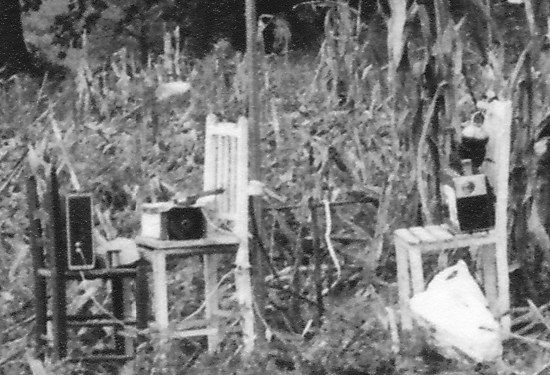 (aus
dem Internet)
(aus
dem Internet)
Questo, unito ad un dipolo a V-invertito in aperta campagna, fece la fortuna
di IBC sulla famosa frequenza di 6275 kHz, quando alla fine dello stesso anno
della famosa "prima volta", iniziarono le trasmissioni regolari.
Il palinsesto era comunque piuttosto limitato: 30 minuti di trasmissione
settimanale, ogni domenica, ripetuta tre o quattro volte durante il giorno.
Il metodo di preparazione delle trasmissioni era e rimase sempre lo stesso: si
registrava di regola il venerdì notte, in quella famosa soffitta, dove era
allestito uno studio piuttosto artigianale. Si assemblavano le collaborazioni
degli amici sparsi un po’ in tutta Italia, che pervenivano sottoforma di
registrazioni, si pensavano rubriche, si preparava un palinsesto musicale, si
leggeva Play DX : una delle caratteristiche di IBC infatti era sempre stata
quella di aggiornare i propri ascoltatori sul loro hobby preferito,il
radioascolto appunto, e la collaborazione tra il bollettino milanese e
l'emittente fu molto stretta; molti lettori si ricorderanno che l'indirizzo di
IBC era presso la redazione di quel bollettino e che ogni settimana Play DX
veniva letto integralmente nel corso del Programma DX.
Per rimanere nell'ambito dei programmi, sicuramente la rubrica fra le più
attese e seguite ogni week-end era "La posta degli ascoltatori", condotta in
studio da "Saverio Masetti": tutte le lettere trovavano un loro spazio, con
soddisfazione di chi ascoltava ma forse con maggior soddisfazione di IBC che
poteva, in questo modo, informare i propri ascoltatori che le trasmissioni
venivano ascoltate in Australia piuttosto che in Finlandia o chissà dove, che
la rubrica "La storia delle telecomunicazioni" a cura di Fabio Veronese era
piaciuta, che l'intervento di Dario Monferini era stato apprezzato, etc, etc,
Via via che il tempo passava i collaboratori aumentavano, le rubriche si
infittivano, e l'apparato tecnico migliorava. Nel periodo del suo massimo
splendore, se così si può dire, IBC trasmetteva ogni sabato e domenica, su
quattro frequenze contemporaneamente. La frequenza di 11585 kHz divenne il
fiore all'occhiello: 200 W, con una portata veramente "mondiale". Insieme
venne anche l'epoca dello scambio dei programmi; fu così che in Australia sui
41 metri ed in Olanda sui 48 metri, IBC vedeva ripetute le proprie emissioni
per quei paesi, restituendo poi il "piacere" attraverso i propri
trasmettitori.
Sempre così arrivò anche l'indirizzo internazionale, una casella postale in
Olanda, come le maggiori emittenti pirate nord-europee dell'epoca. Le
trasmissioni assunsero carattere decisamente più professionale e si
presentarono anche ad un pubblico non soltanto italiano con emissioni in
Inglese, Francese, Tedesco, Spagnolo, Greco e Persiano. Fiorirono iniziative
come, ad esempio, il Diploma d'ascolto ed IBC Newsletter, quest'ultimo poi
naufragato.
Tutto sembrava andare per il meglio ed IBC era decisamente ascoltata ed
apprezzata.
Sorsero però inevitabili problemi : le spese iniziavano ad essere gravose per
una stazione di carattere hobbistico che lo era, in definitiva, sempre meno.
Basti pensare che i rapporti erano oramai oltre cento la settimana, e che
tutti dovevano essere confermati con QSL; le spese per i trasmettitori erano
sempre più ingenti, come quelle per i nastri, l'elettricità, i Diplomi, i
dipoli....
Insomma la gestione era divenuta veramente difficile: fu così che le
trasmissioni divennero sempre più irregolari,si chiusero e timidamente, un
paio di volte, riaprirono, fino a divenire un semplice ricordo.
Dal 2016 però, dopo oltre 30 anni, IBC ha ripreso a trasmettere in onde corte,
prima a carattere sperimentale ed ora con trasmissioni regolari... buon
ascolto!
"IBC DIGITAL" "IBC DIGITAL"
SWITCH NOW TO OLIVIA 16-500(2200 Hz)
Dieser Sender wurde mit einem invertierten V-Dipol in einer ländlichen Gegend *1.) betrieben
und sorgte für den Erfolg von IBC auf dem berühmten Frequenz von 6275 kHz..
Am Ende
des gleichen Jahres
von dem famosen "erste
Mal" begann man mit regelmäßigen Sendungen.
Allerdings war der Sendeplan noch eher begrenzt auf
30 Minuten wöchentlich,
jeden Sonntag, mit drei- oder viermaligen
Wiederholungen während
des Tages.
Das Arrangement der Rundfunksendungen war und blieb immer das Gleiche:
Normalerweise fanden die Aufnahmen Freitag Nacht statt, auf diesem berühmten Dachboden,
wo sich ein kleines Heim-Studio befand.
In Zusammenarbeit mit Freunden aus ganz Italien, welche Audio-Aufnahmen schickten,
wurde ein Programm ersonnen, eine Playlist ausgewählt und es wurde aus "Play DX" gelesen.
Ein wesentliches Merkmal der IBC war immer, die Hörer auf dem aktuellsten Stand zu halten,
was ihr Lieblings-Hobby betraf: Natürlich das Radiohören. Dadurch war die Zusammenarbeit
zwischen der Hobbyzeitschrift aus Mailand
und dem IBC sehr eng.
Viele Leser werden sich sicherlich erinnern, dass Empfangsberichte an IBC
über die Adresse
dieses Nachrichten-Blattes *2.) vermittelt wurden und dass jede Woche "Play DX" vollständig
im Verlauf des DX-Programm vorgelesen wurde.
Wenn man jetzt über die
Programme spricht war ohne Zweifel, an jedem Wochenende,
eines der meistgehörten Programme die Sendung mit "Post von den Zuhörern", unter Leitung von
.....alias "Saverio Masetti".
All die vielen Briefe wurden irgendwie mit in das Programm einbezogen
Andererseits gab es
natürlich auch eine vielleicht noch größere Genugtuung bei der IBC,
wenn man auf diese Weise erfuhr, das die Sendungen sowohl in Australien, oder in Finnland,
oder wo auch immer, gehört werden konnten und das die Rubrik
"Die Geschichte der Telekommunikation" von Fabio Veronese den Hörern gefallen hat,
dass Intervention von Dario
Monferini geschätzt worden sind, etc, etc.
Im Laufe der Zeit gab es mehr Mitarbeiter, mehr Programme und bessere
Übertragungstechnik.
In der Zeit mit dem maximalen Glanz, wenn man es so sagen kann, sendete
IBC gleichzeitig
auf 4 Frequenzen *3.) jeden Samstag und Sonntag. Die 11.585 kHz wurde das Flaggschiff: 200 W, *4.)
mit einem wirklich "globalen" Reichweite. Es war auch die Ära von Austauschprogrammen;
so kam es, dass man in Australien *5.) auf 41 Meter und auf 48 Meter von den Niederlanden *6.) aus
gehört werden konnte. Im Gegenzug übertrug die IBC auch
ausländische Radioprogramme.
Auf diese Weise bekam IBC die internationale Adresse, eine P.O.Box in den
Niederlanden,*7.)
so wie sie auch alle bedeutenden nord-europäischen
Piratensender in dieser Epoche hatten.
Die Programme bekamen einen immer größeren professionellen Charakter und man
wendete
sich nicht mehr nur an ein italienisch sprechendes Publikum. Für eine internationale Hörerschaft
gab es nun Sendungen in Englisch, Französisch, Deutsch,
Spanisch, Griechisch und Persisch (Farsi).
Alles schien gut zu gehen und IBC wurde zweifellos gehört und
geschätzt.
Aber dann fingen unvermeidliche Probleme an: Die Ausgaben wurden immer belastender
für eine Station, die mit Hobby-Charakter begann. Es wurde immer schwieriger.
Wenn man daran denkt, das mehr als einhundert Empfangsberichte jede Woche
eintrafen, und jeder wollte mit einer QSL-Karte bestätigt werden.... Die Kosten für die Sender
wurden immer höher, ebenso die für Magnetbänder, Strom, Diplome, die Antennen.... ....
Kurz gesagt, es wurde immer schwieriger das Ganze zu managen: Die
Radio-Sendungen
wurden immer unregelmäßiger und letztlich ganz eingestellt. Einige Male gab es noch
Wiederaufnahme von Ausstrahlungen, nur um einfach in Erinnerung zu bleiben.
Im Jahr 2016, nach mehr als 30 Jahren, hat IBC wieder mit
Rundfunksendungen
auf Kurzwelle begonnen. Zuerst hatten diese einen experimentellem Charakter - nun gibt
es aber wieder regelmäßige Aussendungen ... Guten Empfang!
*8.)
*9.)
IBC DIGITAL" "IBC DIGITAL"
SWITCH NOW TO OLIVIA 16-500(2200 Hz)
*1.) "colline dell’Appennino Tosco-Emiliano"
*2.) "PLAY DX, Via Davanzati 8 - IT-20158 Milano - Italy
*3.) "IBC Schedule: We broadcast daily a test-transmission on 6275 and 11585 kHz,
from 0500 to 0900 GMT, non stop music.
Regular service: from 09.00 on Saturday to 2000 GMT on Sunday on 6275,
7350 (alt. 7380), 11585 and 17950 kHz......"
*4.) ".....Ascolto del 7 luglio 1982 - Freq. 11590 kHz - Ora 11:35 GMT Potenza 500 Watt...."
*5.) "anno 1982 - lo scambio dei programmi con CBN, Australia..."
"...I just got a blurb sheet in from CBN, the Clandestine Broadcasting Network, of
Australia! They claim to be Australia’s only pirate station and they operate
on 7350 and 13995 kHz and soon plan to serve Melbourne and Sydney on high power FM.
They broadcast every Sunday morning, and should you hear them, the address
to write to is:
CBN, 1 Browns Lane, North Sydney, New South Wales 2060, Australia.
*6.) "anno 1982 - lo scambio dei programmi con Radio Rastafari, Olanda.........."
P.O.Box 162, Bemmel, Holland
*7.) "Italien Broadcasting Corporation, P.O.Box 162, Bemmel, Holland,
*8.) "...Saverio Masetti (English translation by Silvia Cavagnin) ..."
*9.) "...Stefano Mannelli..." ===> http://web.mclink.it/MJ0350/libera/ibc/ibc.htm
